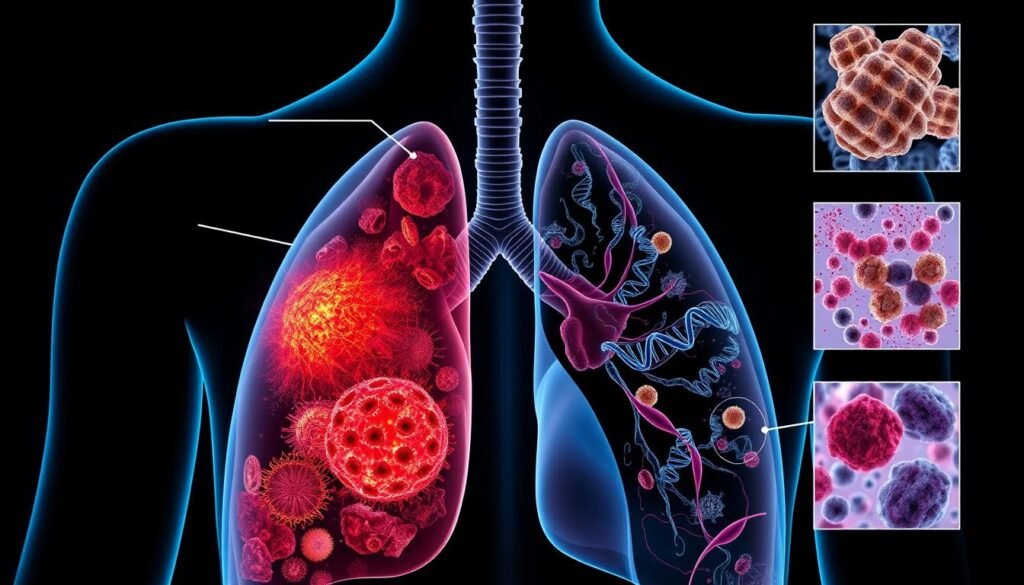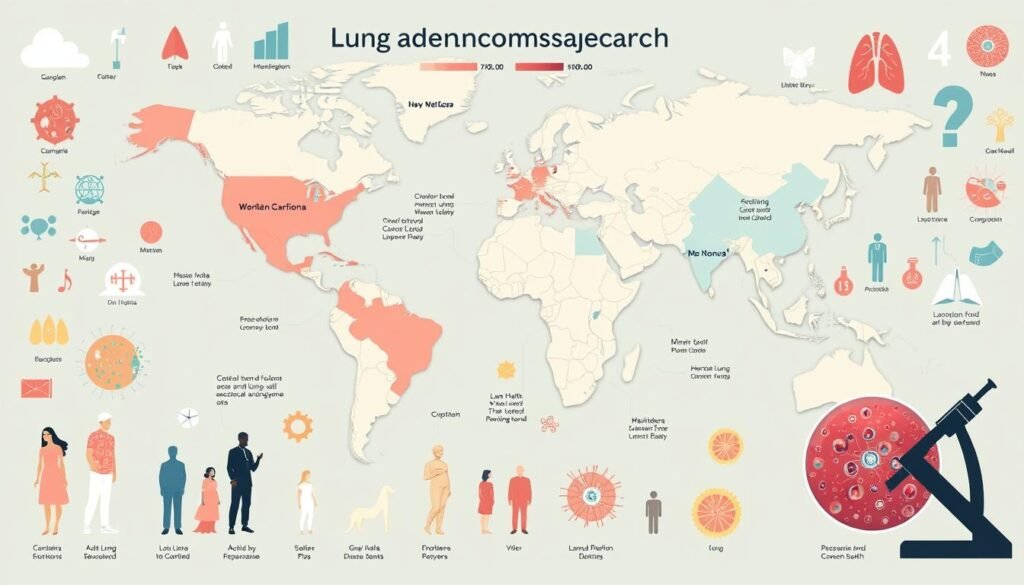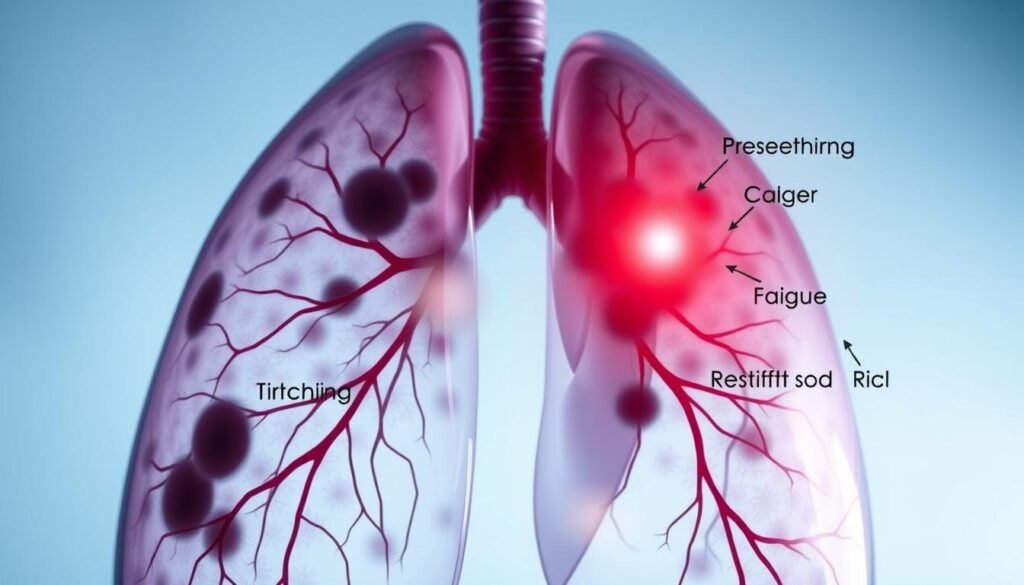Did you know that around 80-85% of lung cancers are called non-small cell lung cancer (NSCLC)? Adenocarcinoma is the most common NSCLC, making up over 30% of lung cancer cases in the U.S. It often starts in the mucosal glands of the lungs. This type is most common in people who have never smoked.
Understanding adenocarcinoma is key. Lung cancer causes many deaths, even with new treatments. There will be about 234,580 new cases of lung cancer in 2024. Learning about adenocarcinoma helps us fight it with better prevention, diagnosis, and treatment.
Key Takeaways
- Adenocarcinoma is the most common subtype of non-small cell lung cancer, making up over 30% of diagnoses.
- This cancer type is prevalent in non-smokers and tends to affect women and younger individuals disproportionately.
- About 80-85% of lung cancers are classified as non-small cell lung cancer (NSCLC).
- Advancements in treatment are crucial as lung cancer remains a leading cause of cancer deaths in the United States.
- Understanding adenocarcinoma’s unique characteristics is vital for proper diagnosis and management.
Introduction to Lung Adenocarcinoma
Lung adenocarcinoma makes up about 40% of all lung cancers. It’s the main type of lung cancer in the United States. This cancer often starts in the lung’s outer areas, coming from glands in the lungs. Its many different signs make it important to learn about this disease.
Early on, this lung tumor might not show symptoms, causing late diagnoses. As it grows, symptoms tend to become more obvious. Even though rates of lung adenocarcinoma are falling, it’s still a top cause of cancer deaths in the U.S. In 2015, around 221,200 new cases were recorded, leading to over 158,000 deaths.
Changes in the p53 gene are key in lung adenocarcinoma’s development, seen in about 52% of cases. The average age at diagnosis is 71. It’s rare in people under 20. High-risk groups, especially heavy smokers, should get screened early with low-dose CT scans.
The five-year survival rate for lung adenocarcinoma is below 12% to 15% worldwide. Yet, progress in treatments like chemotherapy and surgery gives patients new hope. Ongoing research is vital for finding better treatments and improving survival rates for this common lung cancer.
Understanding Non-Small Cell Lung Cancer
Non-small cell lung cancer (NSCLC) is the most common type of lung cancer, making up 80% to 85% of all cases. It is divided into several subtypes including adenocarcinoma, squamous cell carcinoma, and large cell carcinoma. Each of these has unique features that influence the patient’s treatment and prognosis.
Adenocarcinoma is the number one subtype of NSCLC and is found more often in women. It usually affects younger people more than other types of lung cancer do. This cancer starts in the outer parts of the lung, unlike squamous cell carcinoma which begins closer to the center, near the airways.
Large cell carcinoma, another NSCLC subtype, can grow anywhere in the lungs and spreads quickly. This makes treating lung cancer more difficult. On the other hand, small cell lung cancer (SCLC) represents 10% to 15% of lung cancers and spreads fast too.
There are also rare lung tumors, such as carcinoid tumors, which grow slowly and various non-cancerous tumors. Knowing the differences among lung cancer types is crucial. It helps doctors create targeted treatment plans based on each patient’s specific needs.
Adenocarcinoma: The Most Common Type of NSCLC
Adenocarcinoma is the top type of non-small cell lung cancer (NSCLC). It makes up about 40% of lung cancer cases. This cancer starts in the mucus-making gland cells in the lungs’ outer part. It affects both smokers and non-smokers but is more common in women and young people.
The number of adenocarcinoma cases has grown over the years. This increase is seen even as fewer people smoke. This shows that non-smokers also need to be aware. Knowing the different types of NSCLC is key. It helps doctors create better treatment plans and improve patient outcomes.
It’s important to tell adenocarcinoma apart from other NSCLC types, like squamous cell carcinoma and large cell carcinoma. The right treatment depends on knowing its specific characteristics. Healthcare professionals must understand adenocarcinoma well to treat it effectively.
Understanding lung adenocarcinoma’s genetic factors is crucial. A person’s risk can be higher due to family history or gene mutations, such as EGFR and KRAS. Early screening and tailored treatments are essential. They help manage the disease and reduce lung cancer risks.
| Characteristic | Adenocarcinoma | Other Types of NSCLC |
|---|---|---|
| Incidence | Most common type of NSCLC | Less common |
| Primary Risk Group | Includes non-smokers | Typically smokers |
| Location of Origin | Lining of airways | Varied locations in lungs |
| Genetic Factors | Significant role in risk | Less impact from genetics |
Etiology of Lung Adenocarcinoma
The causes of adenocarcinoma involve both our environment and our genes. Smoking tobacco is the main cause, linked to about 80% of non-small cell lung cancer cases. Being around tobacco smoke, even if you’re not the one smoking, can also up your risk for this tough disease.
Jobs that expose you to harmful substances also play a big part. Coming into contact with things like asbestos and silica can make you more likely to get lung adenocarcinoma. Being around radon gas and heavy metals for a long time also ups your chances. It’s critical to have precautions in places where these dangers are present.
Not just the air we breathe, but also our DNA matters in getting lung adenocarcinoma. Studies have found certain changes in genes, like the p53 gene, can lead to cancer in the lungs. Knowing these genetic risks helps us find those who may get sick early on, so we can help them sooner.
Understanding how many things can lead to adenocarcinoma helps us fight it better. It lets us make smarter ways to prevent it and find it early, which can make treatments work better and improve survival chances.

| Risk Factor | Impact on Adenocarcinoma |
|---|---|
| Smoking Tobacco | Accounts for ~80% of cases |
| Occupational Exposure (Asbestos, Silica) | Heightens risk significantly |
| Radon Exposure | Linked to increased lung cancer incidence |
| Genetic Mutations (p53) | Frequent cause of tumorigenesis |
| Environmental Pollution | Long-term exposure can increase risk |
Risk Factors for Adenocarcinoma
Adenocarcinoma is a type of lung cancer influenced by key risk factors. Smoking is a major cause, with most lung cancer deaths in the U.S. linked to it. Smokers are 15 to 30 times more likely to get or die from lung cancer. The risk increases with the amount and years of smoking.
Secondhand smoke is also dangerous and can lead to lung cancer. Environmental factors add to the risk. For instance, radon gas is a big cause of lung cancer among smokers and non-smokers. Exposure to harmful substances like asbestos and diesel exhaust at work also raises the risk, especially for smokers.
Air pollution is another risk factor, especially in industrial areas. Having a family history of lung cancer doubles the risk of developing it. Even those who don’t smoke can be affected by radon, leading to lung cancer deaths in non-smokers.
Certain dietary choices, such as taking beta carotene supplements, might raise lung cancer risks for smokers. It’s key to understand these risks to make smart health choices. For more info on lung cancer risks, check out this resource on lung cancer risks.
Epidemiology of Lung Adenocarcinoma
Lung adenocarcinoma is a major cancer type, leading to many deaths. In 2010, about 239,320 new lung cancer cases were reported in the U.S., causing 161,250 deaths. Globally, it resulted in 1.35 million new cases and 1.18 million deaths. These numbers show it’s a significant health issue worldwide.
In the U.S., lung adenocarcinoma is very common among non-small cell lung cancers. Most patients diagnosed are 65 or older, with an average diagnosis age of 70. It’s the second most common cancer for both genders. There were 115,060 new cases in men and 106,070 in women. Men have a higher incidence rate than women (75.2 vs. 52.3 per 100,000).
The 5-year survival rate for lung cancer remains low at 15.6%. This fact highlights the need for better screening and treatment methods. When cancer is found early, the survival rate goes up to 52%. However, it drops to 3.6% for advanced cases. Lung cancer causes 28% of all cancer deaths in men and 26% in women. This shows why it’s critical to address this disease.

Pathophysiology of Adenocarcinoma
Adenocarcinoma is complex with many types, including adenocarcinoma in situ, minimally invasive, and invasive. Each type affects how patients respond to treatment and their survival chances. Early discovery is key to help patients live longer.
This cancer starts in mucus-making cells, which tells pathologists it’s adenocarcinoma. Different cell and genetic changes make this cancer complex. Changes in specific genes affect what treatment might work best, helping doctors pick the right therapy.
Knowing how adenocarcinoma works is vital for doctors and scientists. It helps them find better ways to diagnose and treat lung cancer. This is especially important as this cancer becomes more common.
Symptoms of Lung Adenocarcinoma
Lung adenocarcinoma is a common non-small cell lung cancer. It shows different symptoms of lung adenocarcinoma. The early stages might not show any signs. But, the later stages usually show clear symptoms.
Some common lung cancer signs are:
- Persistent cough
- Coughing up blood (hemoptysis)
- Shortness of breath
- Chest pain
- Hoarseness
- Unexplained weight loss
- Fatigue
- Recurrent respiratory infections

One serious symptom in advanced stages is Horner syndrome. It affects the eyes and face. This can mean serious complications. Lung tumors might press on important body parts. This can cause superior vena cava syndrome, which includes facial swelling and trouble breathing.
These symptoms can be like those of other conditions. Knowing these signs is important for getting help early. Regular check-ups are key for people at high risk. For more details on symptoms and treatments, check out reputable healthcare sources.
| Symptom | Description |
|---|---|
| Persistent Cough | A cough that doesn’t go away and gets worse over time. |
| Coughing up Blood | When blood comes up with cough, a sign to get checked out. |
| Shortness of Breath | When it’s hard to breathe or catch your breath, leading to tiredness. |
| Chest Pain | Pain or discomfort in your chest, feeling different for everyone. |
| Weight Loss | When you lose weight without trying, it could signal something’s wrong. |
Knowing these symptoms helps raise awareness. It encourages people to get medical advice when needed.
Diagnosis of Adenocarcinoma
To identify adenocarcinoma, a type of lung cancer, doctors carry out detailed exams. They use tests to make an accurate diagnosis and determine the cancer stage.
First, doctors look for lung issues with exams and imaging, like CT scans or MRIs. These help spot tumors and show where and how big they are.
Next, they analyze sputum for cancer cells and might need tissue samples. Using tools like bronchoscopy, they collect these samples to confirm lung adenocarcinoma.
After getting samples, lab tests define the adenocarcinoma type. This step decides the treatment tailored for the patient. Understanding these tests can make treatments more effective.
| Diagnostic Method | Purpose |
|---|---|
| Physical Examination | Initial assessment and identification of symptoms |
| CT Scan / MRI | Visualize tumors and assess their characteristics |
| Sputum Cytology | Identify cancer cells in respiratory secretions |
| Bronchoscopy | Obtain tissue samples from the lungs |
| Mediastinoscopy | Access and biopsy lymph nodes near the lungs |
| Biopsy | Confirm diagnosis through microscopic examination |
Thoroughly diagnosing adenocarcinoma helps in catching it early. This leads to better treatment options and outcomes for patients.
Cancer Staging for Adenocarcinoma
Cancer staging is key for managing and predicting lung adenocarcinoma outcomes. It places the disease into five stages, from Stage 0 to Stage IV. Each stage affects the choice of treatment, matching it to how advanced the cancer is.
The TNM system is used for staging. It looks at tumor size (T), lymph node involvement (N), and spread (M). For example, T1 means the tumor is up to 3 cm, and T4 is when it’s over 7 cm. The N stage tells if lymph nodes are involved, and M shows if there’s distant spread.
Doctors determine the cancer’s stage through tests before starting treatment. Stage IA1 means a tumor under 3 cm without lymph node spread. Stage IIIB shows more serious disease with lymph node involvement. Each stage has its own treatment approach, from surgery to chemoradiation.
Knowing the stage of lung cancer is crucial for the treatment and outlook. It guides the treatment plan and expected results. Preventive steps, like vaccines, can also lower cancer risks. For more on preventing lung cancer with vaccines, visit this resource.
Treatment Options for Lung Adenocarcinoma
The treatment for adenocarcinoma depends on the cancer stage, tumor size, and patient health. Early lung adenocarcinoma can often be cured with surgery. Procedures like lobectomy or pneumonectomy are common.
For bigger tumors or later stages, therapy options change. Stage II may start with neoadjuvant chemotherapy, possibly adding immunotherapy to shrink the tumor before surgery. Stage IIIA treatments often begin with chemoradiation, mixing drugs and radiation for better results.
Stage IIIB cancers typically get chemoradiation too. Stages IVA and IVB might use surgery or radiation if possible. When the cancer spreads far, therapies focus on specific gene mutations like EGFR or ALK. The treatment plan depends on the patient’s health and goals.
After treatment, watching for cancer’s return is crucial. This means regular imaging tests. Tailored treatment plans offer the best chance by using the newest cancer therapies.
Future Directions in Lung Cancer Treatment
The future of lung cancer treatment is bright with exciting progress. It is heading towards personalized care and new therapy methods. Now, doctors look at our genes to pick the best targeted therapies. For example, a type of medicine called tyrosine kinase inhibitors works well for certain gene changes in about 40% of non-small cell lung cancer patients.
Immunotherapy is becoming a key treatment, especially for advanced adenocarcinoma. Drugs like pembrolizumab and atezolizumab have been FDA-approved. They work well for some, but not all, patients. Researchers are testing new ways to combine these drugs to help more people.
Improving how we screen for lung cancer is a big focus. Early detection is vital and can save lives. They’re using low-dose CT scans for people at high risk. Also, new imaging methods, like multi-tracer PET/CT scans, are being developed. These can show us more about the cancer and how it might respond to treatment.
Using machine learning in diagnosing lung cancer is another exciting development. These smart computer programs can correctly identify different lung cancers from CT scans 97% of the time. As technology gets better, it will help us treat people more effectively and improve their chances of survival.
The future of lung cancer treatment is full of hope thanks to advances in targeted therapies, immunotherapy, and tools for diagnosing. Research is moving fast, aiming to make treatments better and give patients facing this tough disease more hope. For more on these advancements, check out this source.
| Key Advancements | Description |
|---|---|
| Genetic Profiling | Identifying mutations for tailored targeted therapy. |
| Immunotherapy | Using agents like pembrolizumab and atezolizumab for advanced disease. |
| Novel Imaging Techniques | Enhancing early detection through multi-tracer PET/CT. |
| Machine Learning | Improving diagnostics with algorithms achieving 97% accuracy. |
Conclusion
Adenocarcinoma is a big challenge in fighting lung cancer. It’s the most common type of non-small cell lung cancer (NSCLC). Understanding its causes, risk factors, and signs is key to handling it well. Health professionals need to know how it affects people differently to improve care.
It’s clear that finding cancer early and new treatments are vital. Tools like low-dose computed tomography (LDCT) help catch it sooner. This means patients have a better chance of living longer. Teaching people about lung cancer risks, like smoking, is also crucial.
The outlook for treating lung adenocarcinoma is hopeful thanks to ongoing research. Efforts in clinical trials, targeted treatments, and immunotherapy are moving us forward. By raising awareness and educating others, we can help everyone affected by this cancer get better care.